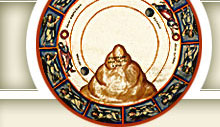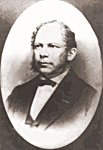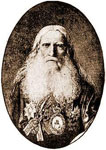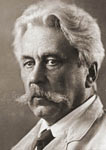The Codex Sinaiticus and the Manuscripts of Mt Sinai in the Collections of the National Library of Russia
Noteworthy among the rich manuscript collections of the National Library of Russia, the first Russia's state public library, are the handwritten books came from the oldest Christian monastic community of St. Catherine's Monastery on Mount Sinai. The Codex Sinaiticus, dating from the 4th century, is the best known of these manuscripts as the earliest and most complete surviving copy of the Greek version of the Scripture (the Septuagint). Written in Biblical uncial script in four columns on parchment, the manuscript holds great interest for scholars not only with virtue of its content and venerable age but also with its remarkable history.
The origins of the Codex Sinaiticus are buried in remote antiquity. The manuscript is thought to be one of the 50 copies of the Bible that Emperor Constantine (272-337) commissioned Bishop Eusebius of Caesarea (260-339) to produce for churches in Constantinople. It is also possible that the splendid manuscript might have been donated by Emperor Justinian to the new monastery established near the foot of Mount Sinai and the church built there (548-560). For fifteen hundred years, the manuscript was preserved at Mt Sinai Monastery, a centre of ascetic and mystic theology, and was first introduced to the research community only in the 19th century.
A distinctive part in discovering, studying and publishing the Codex Sinaiticus was played by the German Biblical scholar Constantin Tischendorff (1815-1874). He paid his first visit to the East in 1844 to explore manuscripts of the New Testament in library collections in Palestine and on Mt Sinai. In late-May 1844, Tischendorff arrived at Mt Sinai Monastery. There, while studying in the library, he discovered 129 leaves of an old manuscript on parchment in a waste basket. Tischendorff was allowed to take 43 leaves to Germany, where he made a lithograph edition of this part of the Codex Sinaiticus. It was published in 1846 under the title of the Codex Frederico-Augustanus and dedicated to King of Saxony who had sponsored Tischendorff's Eastern trip. These 43 leaves of the manuscript, brought by Tischendorff from Mt Sinai were acquired by the Leipzig University Library where they can still be found.
In the process of investigating Eastern monastery libraries, Bishop Porphyrius obtained manuscript fragments for paleographic studies, ordered copies of miniature paintings, and even was presented with icons. The items, brought him from the East, formed a collection of essential research value. Since 1883, the Porphyrius (Uspensky) Collection have been housed in the Manuscripts Department of the National Library of Russia. The collection contains 3 fragments of the Codex Sinaiticus (Shelfmark: Greek 259). Judging from two of the fragments, there can be no question that the old parchment was later reused by the monks for binding repair. Fragments of the Codex Sinaiticus from the Porphyrius Uspensky Collection were published by Tischendorff1.
Tischendorff returned to Mt Sinai in 1853. Yet he could not see the manuscript of his primary interest already hidden by the prudent brethren. While examining other manuscripts, Tischendorff discovered a scrap of the Codex Sinaiticus served as a bookmark in a hagiographic volume. The fragment was included in the celebrated Tischendorff collection, acquired by Imperial Public Library in 1858 and currently kept in the NLR (Shelfmark: Greek 2). The fragment has also been published by some journals of authority2.
To accomplish his research, Tischendorff applies for support from the Russian Government and received it. The grant was used for the scholar's third visit to Mt Sinai where he could see the available leaves of the Codex Sinaiticus: those 86 discovered by him, and the 260 first registered in Bishop Porphyrius's Description - altogether 346 leaves. The monastic housekeeper showed the precious manuscript to Tischendorff in his cell.
From that moment on, Tischendorff began editing the Codex Sinaiticus for the publication that was made possible thanks to sponsorship of the Russian Government, and gained fame throughout the world. The exceptional project of that time was attended with making a confirmatory deed of gift of the Codex to Emperor Alexander II by Mt Sinai community. Diplomats negotiated the donation for some years. The twists and turns of the process are traced by A.V. Zakharova in her article The History of the Acquisition of the Sinai Bible by the Russian Government in the Context of Recent Findings in Russian Archives. In September 1859, by agreement with Mt Sinai community, Tischendorff had taken the manuscript from the monastery to Petersburg in order to prepare the publication, although the deed of gift was signed by the Holy Councils of St. Catherine's Monastery and its daughter house - Cairo Metochion only in November 1869. In return, St. Catherine's community obtained 9,000 rubles from the Russian Government at the time, and consistent Russian support thereafter.
The 4-volume edition of the main portion of the Codex Sinaiticus appeared in 1862 as Bibliorum Codex Sinaiticus Petropolitanus, with dedication to Russian Emperor Alexander II3.
The publication was released in a record short space of time (a mere three years) and impressed everyone by its splendid design and the outstanding quality of printing. Photography and lithography was undertaken in Saint Petersburg and Leipzig, and the printers were Giesecke & Devrient in Leipzig. Some of the copies were printed on special plant-based paper imitating parchment. The edition was published in a run of 327 copies, of which 227 were distributed among major Russian and West-European institutes and libraries, , or presented to eminent persons by the Russian Government's decision. Two copies were forwarded to St. Catherine's - one for the Monastery Library and the other for the library of Cairo House. The publication cost worked out at 20,000 rubles, exclusive of shipping costs. The lithographic facsimile edition of the Codex Sinaiticus drew unprecedented public and scholarly attention and provided a good opportunity for further investigation.
Having a stately audience with Alexander II at Tsarskoe Selo on 10 November 1862, Tischendorff presented the Emperor with the facsimile edition, and the original Codex he used for editing purposes. In 1869, the Codex Sinaiticus entered the Imperial Public Library (a former name of our Library) and was preserved in the Manuscripts Department along with the most important manuscripts like the oldest dated East Slavic book Ostromir Gospel of 1056-1057. In December 1933, the Codex Sinaiticus was sold by the Soviet Government to the British Museum and transferred to London. Since the British Library was established in 1978, the precious manuscript takes its deserving place among the British Library's collections. In London the old manuscript underwent careful conservation treatment, and was bound in two volumes.
However, the efforts of Constantin Tischendorff and Bishop Porphyrius (Uspensky) to discover parts of the Codex Sinaiticus at St. Catherine's Monastery of Mt Sinai, and the grandiose facsimile edition of the monument did not represent the final event in the history of discovery of the ancient relic. Over the course of time, other parts of the Codex Sinaiticus have been found, and other facsimile editions of the treasure have been printed using advanced techniques.
Towards the end of the 19th century the Society of Lovers of Ancient Literature in Saint Petersburg (OLDP) acquired a fragment of a parchment leaf bearing a washed Greek text. Vladimir Beneshevich deciphered, identified and published the text in his catalogue of Mt Sinai St. Catherine's manuscripts, attributing the fragment to the Codex Sinaiticus4.
The fragment from the Library of the Society of Lovers of Ancient Literature is reproduced in a facsimile of the Codex Sinaiticus prepared by Helen and Kirsoff Lake. In contrast to Tischendorff's lithograph version, the Lakes made their edition from photographs. The Codex Sinaiticus was photographed in Petersburg in summer 1908. The fragment from the collection of the Society of Lovers of Ancient Literature was taken by the prominent photographer Karl Bulla in 1916. The Lake edition was published in two volumes in 1911 and 1922 respectively5.
In 1932 the collection of the Society of Lovers of Ancient Literature added to the holdings of the Public Library a considerable number of manuscripts, among them one further fragment of the Codex Sinaiticus (Shelfmark: OLDP. O. 156).
A quite small fragment of parchment with Greek text was discovered in a manuscript of the collection of Bishop Porphyrius (RNB. F. �. I. 83). On the basis of the paleographic characteristics, Evgenia Eduardovna Granstrem determined it as part of the Codex Sinaiticus and identified the text as the fragment of The Shepherd of Hermas6. The discoved fragment has been placed in the library's collection of Greek manuscripts at the shelfmark Greek 843.
History of the discovery of the Codex Sinaiticus concludes with exciting finds in St Catherine's Monastery on Mt Sinai. During the reconstruction works on the building on 26 May 1975, a forgotten store-room, where damaged and decrepit books had been kept at one time, was found out under St. Gregory Chapel at the north-western wall of the monastery. Among the books were 12 leaves and 24 fragments of the Codex Sinaiticus.
Most recently, on 3 September 3 2009, an interesting report about one more sensation appeared on the Internet, referring to an article by The Independent newspaper. Nicholas Sarris, a member the Codex Sinaiticus Project, noticed a previously unseen piece of Codex Sinaiticus glued to the binding of a book, when he was looking through photographs of manuscript bindings in the library of St Catherine's Monastery. Archimandrite and the librarian of St Catherine's Monastery on Mt Sinai, Father Justin confirmed that the sheet was a part of the Codex Sinaiticus, and identified the text as the beginning of the Book of Joshua, Chapter 1, Verse 10.
It is hard to tell whether more fragments of the Codex Sinaiticus will ever came to light. Today different parts of the precious codex are held across four world famous manuscript treasuries - St Catherine's Monastery on Mt Sinai, the British Library, Leipzig University Library, and the National Library of Russia in St Petersburg. Their official representatives signed a partnership agreement on the international Codex Sinaiticus Project in London, March 2005. The project is planned to end in 2010. Outcomes of the project will include: 1) the preservation of all leaves of the Codex Sinaiticus according to a common standard; 2) the digitisation of all parts of the Codex into a common format; 3)the transcription of the Codex with expert commentary; 4) the online publication of the Codex; 5) new research into the history of the Codex. The project aims have been nearly accomplished, and the experience of international cooperation in preserving, studying and publishing written heritage items of world importance has provided an essential foundation for the continuation of this noble humanitarian activity.
As part of the Codex Sinaiticus Project, the National Library of Russia will host the international conference The Codex Sinaiticus: Manuscripts in Modern Information Environment (the 5th Zagrebin Readings) on 12-13 November 2009 in Saint Petersburg. For the conference members and visitors, the NLR offers an exhibition of rare manuscripts in the ancient rooms of the Manuscripts Department. This display is accompanied by the online exhibition that provides access to the unique treasures of world culture in the collections of the National Library of Russia to a global audience. The virtual exhibition was produced by staff members of the Library's Department of Manuscripts C.Krushelnitskaya, I.Lebedeva, Zh.Levshina, T.Romanova, E.Borisovets, the lecturer at the Chair of General Art History of the Lomonosov Moscow State University A.Zakharova, the web-master V.Chernousova, the designer I.Podoprigora and the translator I.Rozhkova.
C.Krushelnitskaya,
Head of the Old Russian Manuscripts Section
Learn more about the history of the acquisition of the Sinai Bible by Russia in the light of recent discoveries in Russian archives
List of illustrations
1 � C. Tischendorff Appendix codicum celeberrimorum Sinaitici Vaticani Alexandrini. Lipsiae, 1867. S. XVI-XVII, 3-7. (back to the text)
2 � The fragment was reproduced as illustration in the following publications: 1)C. Tischendorff Monumenta sacra inedita. Nova collection II. Leipzig, 1857. S. XXXXVI, 321-322, Table 6; 2) C. Tischendorff Appendix codicum celeberrimorum Sinaitici Vaticani Alexandrini. Lipsiae, 1867. S. XVI, 3-7; 3) J.-B. Thibeaut. Monuments de la notation ekphonétique et hagiopolite de l'église grecque. St.-Petersburg, 1913. 2. Ill. no 2; 4) H. Lake, K. Lake. Codex Sinaiticus Petropolitanus (et Friderico-Augustanus Lipsiensis). The New Testament� preserved in the Imperial Library of St.-Petersburg (The Old Testament etc.) now reproduced in facsimile from photographs� with a description and introduction. I-II. London, 1911-1922. (back to the text)
3 � [Bibliorum Codex Sinaiticus Petropolitanus. Auspiciis augustissimis imperatoris Alexandri II, ex tenebris protraxit in Europam transtulit ad iuvandas atque illustrandas sacras litteras edidit� Vols. I-IV. I: Prolegomena. Commentarius. Tabulae; II: Veteris Testamenti pars prior; III: Veteris Testamenti pars posterior; IV: Novum Testamentum cum Barnaba et Pastore. Petropoli, 1862. Reprint: Hildesheim (Georg Olms), 1969.] (back to the text)
4 � A Description of Greek Manuscripts in St Catherine's Monastery on Mt Sinai Vol. 1: Remarkable Manuscripts in the Library of Mt Sinai Monastery and Mt Sinai House in Cairo Djuvania, Described by Archimandrite Porphyrius Uspensky. Published by the Imperial Academy of Sciences with money bequeathed to it by Bishop Porphyrius, under the editorship and with additions of V.N. Beneshevich. Saint Petersburg, 1911. Pp. 639-642. Reprint: Hildesheim, 1965. (back to the text)
5 � H. Lake, K. Lake. Codex Sinaiticus Petropolitanus et Friderico Augustanus Lipsiensis. The New Testament� preserved in the Imperial Library of St.-Petersburg (The Old Testament etc.) now reproduced in facsimile from photographs� with a description and introduction. I-II. London, 1911-1922. (back to the text)
6 � E. E. Granstrem. Greek Manuscripts in the State Public Library after M. Ye. Saltykov-Shchedrin. Vizantiiskii vremennik. 1959. Vol. 16. P. 220. No 2. (back to the text)




